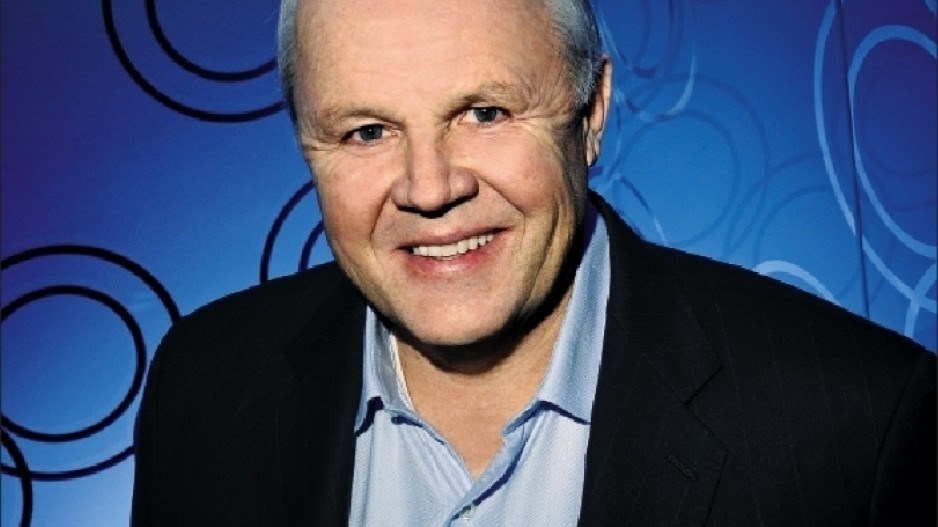Even before Apple launched the iPhone in 2007, the leaders in B.C.’s digital and wireless sectors could see that mobile was exploding.
To compete with the U.S., with its vast venture capital pools, B.C. start ups in the wireless sector would need help, so they secured $4.2 million in provincial funding and launchedJames Maynard, Wavefront’s CEO, thinks he can push that to 150 new companies and 6,000 jobs by 2016.
“Mobile is going to change the world,” he declares. “It’s the fastest wave of technology to ever sweep the planet. It’s one of the few technologies that has a direct correlation between adoption and economic wealth creation. What’s going to happen over the next five years, it is going to change the way we govern, communicate, transport goods and deliver health care.”
It’s that kind of evangelism – plus his skills as a salesman and background in telecommunications – that helped Maynard land the CEO’s job at Wavefront.
Caroline Lewko, who was then chairwoman of WINBC, Wavefront’s forerunner, was instrumental in lining Maynard up for the job.
“At the time, in Canada, we were all talking about biotech and fuel cells, and there were very few of us who understood the vision of mobile,” said Lewko, who is now CEO of the Wireless Industry Partnership Connector Inc. (WIP).
“I needed somebody who understood that vision – that this mobile thing was actually going to go somewhere – and he got that.”
Maynard grew up in Moose Jaw, Saskatchewan, and got his start in the telecommunications field working for SaskTel. He moved to Vancouver in 1985 and joined Sun Microsystems in 1987, working in sales management and market development.
Maynard still considers his greatest strength to be his salesmanship.
“I never miss a target,” he said.
Maynard eventually turned entrepreneur and was involved in a number of startups. He founded VST Canada in 2002, which was acquired by VST International, and was part of the team that concluded a joint venture with Daktronics to create Fuelcast Media Networks, which made digital signage on gas pumps.
Maynard left Fuelcast in 2006 and was hired to head the newly formed Wavefront in 2007.
Wavefront helps wireless companies reach commercialization. Roughly 300 companies have used its services, which include mentoring, market links and access to hardware and networks.
“One of the things about the wireless space is that it’s very expensive,” Maynard said. “One of the first things we were able to do is create access to a whole number of shared services that would normally be beyond the economic reach of most small companies.”
The problem for any company involved in the wireless sector is that every country or region has its own wireless ecosystem. A handset that works in North America might not work in Europe or China, and vice versa, so every device intended for sale outside of Canada has to be tested on foreign networks, and mobile applications need to be tested on hundreds of different devices.
Wavefront provides its companies with two key services: access to wireless networks outside of Canada and a library of 400 mobile phones and smartphones from all over the world.
It also provides office space and a range of other business services.
Having access to networks and hardware for testing dramatically lowers the costs of R&D for startups like Mobify – one of Wavefront’s success stories.
Mobify scales websites for tablets and smartphones. The company’s founder and CEO, Igor Faletski, credits Wavefront with helping the company grow more quickly than it might otherwise have.
“For us, one of the most important things was access to their device library and office space,” Faletski said.
In addition to providing access to hardware, Wavefront also provides access to big players in the wireless space through its partnerships with Rogers (TSX:RCI), Sierra Wireless (TSX:SW), Nokia, Ericsson, Samsung and Microsoft.
“The thing that’s really made a difference, that I think sets us apart from the other accelerators and capacity builders, is access to customers,” Maynard said. “Because wireless is an international game, most of the customers for most of these guys will be from outside of Canada.”
The accelerator now has 23 employees and national operations in Toronto and Ottawa. Last year, Wavefront joined a national network of Centres of Excellence for commercialization and research under the National Research Council, which is providing Wavefront with $11.6 million in funding.
Maynard plans to build that funding into $400 million in new GDP by 2016 through the commercialization of new wireless companies.
Wavefront’s latest initiative has been a partnership with Rogers and Sierra Wireless to support and drive what Maynard said will be the next major wave in the wireless space – machine-to-machine communication – through a new M2M accelerator program
It’s an area that is exploding, according to Juniper Research, which projects M2M business will generate $35 billion globally by 2016. Maynard sees Canada’s role in the M2M movement – the Internet of things – to be part of a great Canadian tradition in telecommunications.
“Canadian companies have been major leaders in every major wave of telecom innovation,” Maynard said. “Track it back to Alexander Graham Bell and Marconi, whether it’s broadband or smartphones – which is really [Research in Motion (TSX:RIM)], which launched the last wave of innovation.
“The next wave is machine to machine. And here we have another Canadian company, in Richmond [Sierra Wireless], which is a global leader in that space.” •




